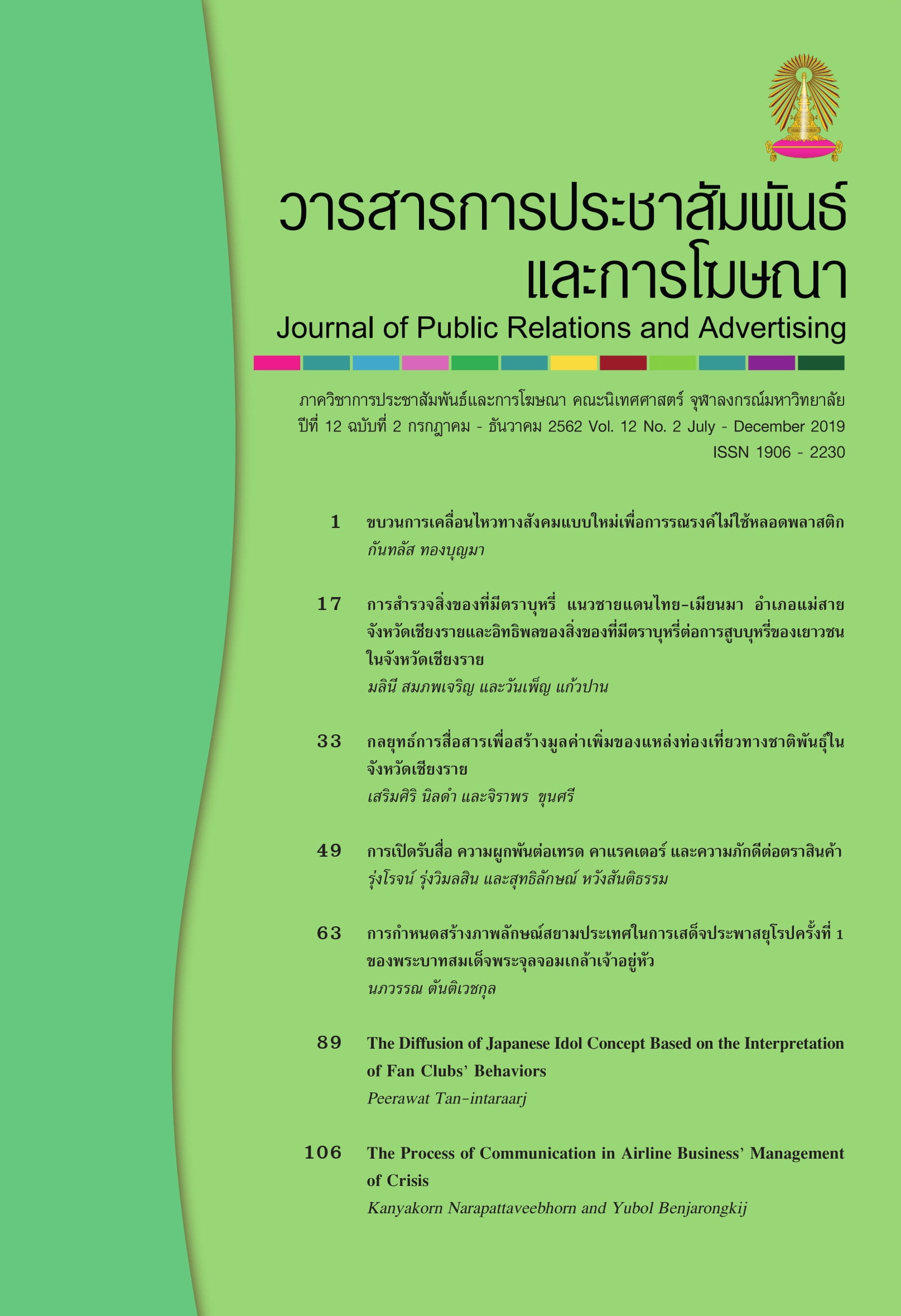Cigarette Promotional Items Surveys along Thailand and Myanmar Border Crossing Point at Mae Say District, Chiang Rai Province and Influence of Cigarette Promotional Items toward Smoking Behavior of Youth in Chiang Rai Province
Main Article Content
Abstract
This mixed method research study aims to conduct the cigarette promotional items surveys in the markets along Thailand and Myanmar border crossing point at Mae Say District, Chiang Rai Province, and explore sources of cigarette promotional items (CPIs) purchased by students in Chiang Rai Province, as well as examine influences of CPIs on smoking among students and undergraduate students in Chiang Rai Province. The data were collected through the observation along with the checklist to conduct the CPIs checklist forms applying along Thailand-Myanmar border market. Also, the questionnaire was used to conduct the surveys with 252 students and undergraduate students in Chiang Rai Province, and the in-depth interview was conducted with 10 samples to obtain the data regarding sources of purchasing CPIs and influences of CPIs on smoking. The findings revealed that cigarette promotional items were not available for sales in the markets along Thailand border, but these items were available in the markets along Myanmar border. The sources of purchasing CPIs in Chiang Rai Province included the small and large grocery stores where many shoppers visited regularly and the market places in front of schools. The influences of CPIs as previously seen or collected did not have impacts on smoking. The surveillance on the release of CPIs should be made, focusing on the smuggle of the CPI products from Myanmar for sales in any area far away from Thailand border, including the surveillance on the online trading of CPIs as the online markets are open 24 hours a day, and the law enforcement has been inactive.
Article Details
References
นิทัศน์ ศิริโชติรัตน์, พิมพ์พรรณ ศิลปสุวรรณ,ชูเกียรติ วิวัฒน์วงษ์เกษม, ดุสิต สุจิรารัตน์, ปรารถนา สถิต, วิภาวี, นฤมล เอื้อมณีกุล, นรินทร์ ปานดี และมลินี สมภพเจริญ. (2560). ความคิดเห็นต่อภาพคำเตือนบนซองบุหรี่แบบเรียบและผลต่อความเกรงกลัวอันตรายของบุหรี่ในกลุ่มเยาวชนที่ไม่สูบบุหรี่. วารสารศาสตร์, 10(3), 269-302.
ประกิต วาทีสาธกกิจ. (2559). Next step of Action on Smoking and Health Foundation Thailand. วันที่เข้าถึงข้อมูล 4 พฤษภาคม 2561 แหล่งที่มา http://www.ashthailand.or.th/content_attachment/attach/eaf29e1.pdf.
ปรีชา อุปโยคิน, พลวัฒ ประพัฒน์ทอง และภัทรา ชลดำรงค์กุล. (2560). ความหลากหลายกลุ่มชาติพันธุ์ กับการพัฒนาเศรษฐกิจชายแดนในอำเภอแม่สาย จังหวัดเชียงราย. วารสารสังคมศาสตร์. คณะรัฐศาสตร์.จุฬาลงกรณ์มหาวิทยาลัย. 47(1): 81-105.
มลินี สมภพเจริญ, วันเพ็ญ แก้วปาน และปาหนัน พิชยภิญโญ. (2556). ช่องทางการจัดจำหน่ายสิ่งของที่มีตราบุหรี่ (Cigarette promotional items : CPI). สิ่งที่ผู้ขายก็ไม่รู้ ผู้ซื้อก็ไม่ทราบว่า...ผิดกฎหมาย.วารสารนิเทศศาสตร์, 31(2), 27-36.
โรงงานยาสูบ กระทรวงการคลัง. (2561). Product of Thailand Tobacco Monopoly. วันที่เข้าถึงข้อมูล 5 พฤษภาคม 2561 แหล่งที่มา http://www.thaitobacco.or.th/
วิภวานี เผือกบัวขาว, ประสารโชค ธุวะนุติ และชนัต เผ่าพันธุ์ดี. (2560). การกำหนดนโยบายส่งเสริมการค้าชายแดนไทย - เมียนมา จังหวัดประจวบคีรีขันธ์. Veridian E-Journal ฉบับภาษาไทย สาขามนุษยศาสตร์ สังคมศาสตร์และศิลปะ, Silpakorn University, 10(3), 68-85.
ศูนย์วิจัยและจัดการความรู้เพื่อการควบคุมยาสูบ(ศจย.) มหาวิทยาลัยมหิดล. (2556). สรุปสถานการณ์ตัวชี้วัดตามยุทธศาสตร์การควบคุมการบริโภคยาสูบของประเทศไทย ปี 2556. วันที่เข้าถึงข้อมูล 22 มิถุนายน 2561. แหล่งที่มา http://www.trc.or.th
ศูนย์วิจัยและจัดการความรู้เพื่อการควบคุมยาสูบ(ศจย.) มหาวิทยาลัยมหิดล. (2558). รายงานการประชุมบุหรี่และสุขภาพแห่งชาติ ครั้งที่ 14 “หนุนกฎหมายบุหรี่ใหม่เพื่อคุณภาพชีวิตคนไทย”.
ศูนย์วิจัยและจัดการความรู้เพื่อการควบคุมยาสูบ(ศจย.) มหาวิทยาลัยมหิดล. (2559). รายงานผลการประเมินการปฏิบัติตามกรอบอนุสัญญาว่าด้วยการควบคุมยาสูบของประเทศไทย พ.ศ. 2559. กรุงเทพมหานคร : เจริญดีมั่นคงการพิมพ์.
สำนักควบคุมการบริโภคยาสูบ กรมควบคุมโรค กระทรวงสาธารณสุข. (2560). พระราชบัญญัติควบคุมผลิตภัณฑ์ยาสูบ พ.ศ. 2560. ปทุมธานี : โรงพิมพ์มหาวิทยาลัยธรรมศาสตร์.
Brock, B., Schillo A. B., Moilanen, M. (2015). Tobacco industry marketing : an analysis of direct mail coupons and giveaways. Tob Control, 24, 505-508.
Clow, E. K., and Baack, D. (2007). Integrated advertising, promotion and marketing communication. 3rded. Pearson Education Limited, Upper Saddle River. New Jersey.
Fisher, M. P., Schwartz, M. P., Richards, J. W. (1991). Brand Logo Recognition by Children Aged 3 to 6 Years Mickey Mouse and Old Joe the Camel. JAMA, 266(22), 3145-3148.
Ganz, O., Teplitskaya, L., Cantrell J., Hair, C. E., and Vallone, D. (2016). Direct-to-Consumer marketing of cigar products in the United States. Nicotine & Tobacco Research, 18(5), 864-868.
Grant-Braham, B., and Britton, J. (2012). Motor racing, tobacco company sponsorship, barcodes and alibi marketing. Tab Control, 21(6), 529-535.
KItchen, P. J. (2010). Integrated brand marketing and measuring returns. Hampshire: Palgrave Macmillan, 68.
Lempert, L. K., Glantz, S. A. (2018). Tobacco industry promotional strategies targeting American Indians/Alaska Natives and exploiting tribal sovereignty. Nicotine & Tobacco Research, 1-9.
Owotomo, O., Maslowsky,J., Pasch,K.E. (2017). Historical declines and disparities in cigarette coupon saving among adolescents in the United States, 1997-2013. Preventive Medicine, 100, 61-66.
Pechmann, C., and Ratneshwar, S. (1994).The effect of antismoking and cigarette advertising on young adolescents’ perceptions of peers who smoke. Journal of Consumer Research, 21, 236-251.
Sargent, J. D., Dalton M. A., Beach, M., et al. (1997). Cigarette promotional items in public school. Arch Pediatr Adolesc Med, 151(12), 1189-1196.
Schroeder, J. E., and Detlev Zwick. (2004). Mirrors of masculinity : representation and identity in advertising images. Consumption Markets & Culture, 7(1), 21-52.

